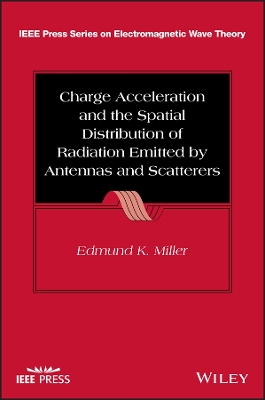IEEE Press Series on Electromagnetic Wave Theory
2 total works
Charge Acceleration and the Spatial Distribution o f Radiation Emitted by Antennas and Scatterers
by Edmund Miller and Dragan Poljak
An Exploratory Work on the Process of Generating EM Waves with Antennas and Targets
In Charge Acceleration and the Spatial Distribution of Radiation Emitted by Antennas and Scatterers, the well-qualified and experienced author provides a comprehensive blueprint to understanding the difficult-to-grasp physical phenomenon of EM waves. Specifically, the goal of the work is to provide the reader with a conceptual basis for thinking about and understanding EM radiation. This goal is accomplished by describing an alternative to a rigorous mathematical formalism that may obscure the physical reality of radiation processes. The approach taken in the work seeks to provide maximum relevance regarding how engineers routinely model and design radiating structures as boundary-value problems.
Rather than developing and presenting a formal theoretical foundation of electromagnetic theory, this book instead focuses on various aspects of EM radiation from a variety of different perspectives. Some of the topics covered include:
- The e-field kink model, time-domain results for a simple wire object, and time-domain energy flow and radiation from a straight wire and circular loop
- Additional results for time-domain radiation and radiation from a matched load in the time domain
- Development of TDFARS and TWTD, TDFARS results, development of FDFARS and NEC, and FDFARS results
- Radiation decay of frequency-domain power flow, comparing results from FDFARS and TDFARS, and radiation phenomena and poles
Students and teachers of electromagnetics will find value in the work by being able to better holistically conceptualize the complicated phenomenon of EM waves. Research engineers in related industries may also benefit from the work and be able to use the concepts therein to fuel innovation in both the public and private sectors.
Deterministic and Stochastic Modeling in Computational Electromagnetics
by Dragan Poljak and Anna Susnjara
Help protect your network with this important reference work on cyber security
Deterministic computational models are those for which all inputs are precisely known, whereas stochastic modeling reflects uncertainty or randomness in one or more of the data inputs. Many problems in computational engineering therefore require both deterministic and stochastic modeling to be used in parallel, allowing for different degrees of confidence and incorporating datasets of different kinds. In particular, non-intrusive stochastic methods can be easily combined with widely-used deterministic approaches, enabling this more robust form of data analysis to be applied to a range of computational challenges.
Deterministic and Stochastic Modeling in Computational Electromagnetics provides a rare treatment of parallel deterministic-stochastic computational modeling and its beneficial applications. Unlike other works of its kind, which generally treat deterministic and stochastic modeling in isolation from one another, it aims to demonstrate the usefulness of a combined approach and present particular use-cases in which such an approach is clearly required. It offers a non-intrusive stochastic approach which can be incorporated with minimal effort into virtually all existing computational models.
Readers will also find:
- A range of specific examples demonstrating the efficiency of deterministic-stochastic modeling
- Computational examples of successful applications including ground penetrating radars (GPR), radiation from 5G systems, transcranial magnetic and electric stimulation (TMS and TES), and more
- Introduction to fundamental principles in field theory to ground the discussion of computational modeling
Deterministic and Stochastic Modeling in Computational Electromagnetics is a valuable reference for researchers, including graduate and undergraduate students, in computational electromagnetics, as well as to multidisciplinary researchers, engineers, physicists, and mathematicians.

